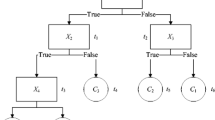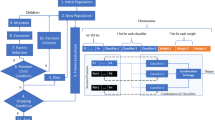Abstract
Obstructive sleep apnea syndrome (OSAS) is an important disease that affects both the right and the left cardiac ventricle. This paper presents a novel classification method called pairwise ANFIS based on Adaptive Neuro-Fuzzy Inference System (ANFIS) and one against all method for detecting the obstructive sleep apnea syndrome. In order to extract the features related with OSAS, we have used the clinical features obtained from Polysomnography device as a diagnostic tool for obstructive sleep apnea (OSA) in patients clinically suspected of suffering from this disease. The clinical features obtained from Polysomnography Reports are Arousals Index (ARI), Apnea and Hypoapnea Index (AHI), SaO2 minimum value in stage of REM, and Percent Sleep Time (PST) in stage of SaO2 intervals bigger than 89%. Since ANFIS has output with one class, we have extended the output of ANFIS to multi class by means of one against all method to diagnose the OSAS that has four classes consisting of normal (25 subjects), mild OSAS (AHI = 5–15 and 14 subjects), middle OSAS (AHI < 15–30 and 18 subjects), and heavy OSAS (AHI > 30 and 26 subjects). The classification accuracy, sensitivity and specifity analysis, mean square error, and confusion matrix have been used to test the performance of proposed method. The obtained classification accuracies are 82.92%, 82.92%, 85.36%, and 87.80% for each class including normal, mild OSAS, middle OSAS, and heavy OSAS using ANFIS with one against all method with 50–50% train-test split, respectively. Combining ANFIS and one against all method that is firstly proposed by us was firstly applied for diagnosing the OSAS. The proposed method has produced very promising results in the detecting the obstructive sleep apnea syndrome.










Similar content being viewed by others
References
AASM., Sleep-related breathing disorders in adults: Recommendations for syndrome definition and measurement techniques in clinical research. The Report of an American Academy of Sleep Medicine Task Force. Sleep. 22(5), 1999.
Kaltz, E. S., Lutz, J., Black, C., and Marcus, C. L., Pulse transit time as a measure of arousal and respiratory effort in children with sleep-disorder breathing. Pediatr. Res. 53:4580–588, 2003.
Al-Ani, T., Hamam, Y., Novak, D., Pozzo Mendoza, P. T, Lhotska, L., Lofaso, F., et al., Noninvasive automatic sleep apnea classification system. BioMedSim'05, Linköping, Sweden, May 26–27, 2005.
Al-Angari, H. M., and Sahakian, A. V., Use of sample entropy approach to study heart rate variability in obstructive sleep apnea syndrome. IEEE Trans. Biomed. Eng. 54:1900–1904, 2007.
del Campo, F., Hornero, R., Zamarro’n, C., Abasolo, D. E., and A’lvarez, D., Oxygen saturation regularity analysis in the diagnosis of obstructive sleep apnea. Artif. Intel. Med. 37:111–118, 2006.
Kwiatkowska, M., and Schmittendorf, E., Assessment of obstructive sleep apnea using pulse oximetry and clinical prediction rules: A fuzzy logic approach. BMT, 2005.
OSA—Polysomnography. Retrieved February 2007 from http://classes.kumc.edu/cahe/respcared/cybercas/sleepapnea/trenpoly.html (last accessed: February, 2007).
Rechtschaffen, A., and Kales, A., A manual of standardized terminology, techniques and scoring system for sleep stages of human subjects. US Government-Printing Office, National Institutes of Health Publication No. 204, Washington, DC, 1979.
American Thoracic Society Consensus Statement, Indications and standards for cardiopulmonary sleep statement. Am. Rev. Respir. Dis. 139:559–568, 1989.
American Academy of Sleep Medicine Task Force, Sleeprelated breathing disorders in adults: Recommendations for syndrome definition and measurement techniques in clinical research. Sleep. 22:667–689, 1999.
Douglas, N. J., Thomas, S., and Jan, M. A., Clinical value of polysomnography. Lancet. 339:347–350, 1992.
Güler, İ., and Übeyli, D. E., Adaptive neuro-fuzzy inference system for classification of EEG signals using wavelet coefficients. J. Neurosci. Methods. 148:113–121, 2005.
Jang, J.-S. R., Self-learning fuzzy controllers based on temporal backpropagation. IEEE Trans. Neural Netw. 3:5714–723, 1992.
Polat, K., and Güneş, S., A hybrid medical decision making system based on principles component analysis, k-NN based weighted pre-processing and adaptive neuro-fuzzy inference system. Digit. Signal Process. 16:6913–921, 2006.
Mean, variance, and mean square error. Retrieved February 2008 from http://www.fmi.uni-sofia.bg/vesta/Virtual_Labs/freq/freq5.html.
Liu, Y., and Zheng, Y. F., One-against-all multi-class SVM classification using reliability measures, Neural Networks, 2005. IJCNN’05. Proceedings. 2005 IEEE International Joint Conference on Volume 2, 31 July–4 Aug. 2005, pp 849–854.
Jeff Schneider’s Home Page. Retrieved February 2008 from http://www.cs.cmu.edu/~schneide/tut5/node42.html.
Acknowledgements
This study has been supported by Scientific Research Project of Selcuk University.
Author information
Authors and Affiliations
Corresponding author
Rights and permissions
About this article
Cite this article
Polat, K., Yosunkaya, Ş. & Güneş, S. Pairwise ANFIS Approach to Determining the Disorder Degree of Obstructive Sleep Apnea Syndrome. J Med Syst 32, 379–387 (2008). https://doi.org/10.1007/s10916-008-9143-y
Received:
Accepted:
Published:
Issue Date:
DOI: https://doi.org/10.1007/s10916-008-9143-y




